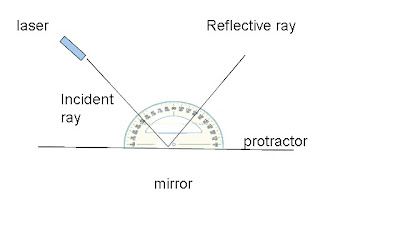
Today we learned about how the laser reflects off of a curved mirror. How would the laser travel? The protractor has a invisible normal line, also known as 90 degrees. The formula we followed was m
Our procedures for finding the reflective ray is:
1. Place a mirror on a flat surface.
2. Put the protractor perpendicular to the mirror.
3. Shine the lazer at the mirror through the protector, perpendicular to the mirror.
4. Point the incident ray at the mirror through the protractor to get a reflective ray.
5. Repeat by starting at 10 degrees and increase by 10 degrees until you hit 90 degrees.
This was my prediction for:
10 degrees- 10 degrees
20 degrees- 20 degrees
30 degrees- 32 degrees
40 degrees- 40 degrees
50 degrees- 55 degrees
60 degrees- 63 degrees
70 degrees- 71 degrees
80 degrees- 87 degrees
90 degrees- 90 degrees
Our class data was for the actual measurement:
10 degrees- 12 degrees
20 degrees- 21 degrees
30 degrees- 30 degrees
40 degrees- 41 degrees
50 degrees- 52 degrees
60 degrees- 61 degrees
70 degrees- 70 degrees
80 degrees- 79 degrees
90 degrees- 90 degrees
S.D
Our procedures for finding the reflective ray is:
1. Place a mirror on a flat surface.
2. Put the protractor perpendicular to the mirror.
3. Shine the lazer at the mirror through the protector, perpendicular to the mirror.
4. Point the incident ray at the mirror through the protractor to get a reflective ray.
5. Repeat by starting at 10 degrees and increase by 10 degrees until you hit 90 degrees.
This was my prediction for:
10 degrees- 10 degrees
20 degrees- 20 degrees
30 degrees- 32 degrees
40 degrees- 40 degrees
50 degrees- 55 degrees
60 degrees- 63 degrees
70 degrees- 71 degrees
80 degrees- 87 degrees
90 degrees- 90 degrees
Our class data was for the actual measurement:
10 degrees- 12 degrees
20 degrees- 21 degrees
30 degrees- 30 degrees
40 degrees- 41 degrees
50 degrees- 52 degrees
60 degrees- 61 degrees
70 degrees- 70 degrees
80 degrees- 79 degrees
90 degrees- 90 degrees
S.D
No comments:
Post a Comment